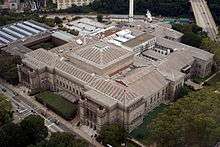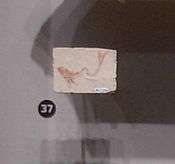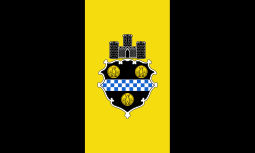Carnegie Museum of Natural History
Carnegie Museum of Natural History (abbreviated as CMNH) located at 4400 Forbes Avenue in the Oakland neighborhood of Pittsburgh, Pennsylvania, was founded by the Pittsburgh-based industrialist Andrew Carnegie in 1896. It maintains an international reputation for research and is ranked among the top five natural history museums in the United States.[1]

One of the four Carnegie Museums of Pittsburgh | |
 Location of Carnegie Museum in Pennsylvania  Carnegie Museum of Natural History (Pennsylvania)  Carnegie Museum of Natural History (the United States) | |
| Established | 1895 |
|---|---|
| Location | Pittsburgh, Pennsylvania |
| Coordinates | 40.44358°N 79.950560°W |
| Type | Natural History |
| Visitors | 300,000 |
| Director | Eric Dorfman |
| Public transit access | 54, 58, 61A, 61B, 61C, 61D, 67, 69 |
| Nearest parking | On site and street |
| Website | carnegiemnh |
Description and history
The museum consists of 115,000 square feet (10,700 m2) organized into 20 galleries as well as research, library, and office space. It holds some 22 million specimens, of which about 10,000 are on view at any given time and about 1 million are cataloged in online databases. In 2008 it hosted 386,300 admissions and 63,000 school group visits. Museum education staff also actively engage in outreach by traveling to schools all around western Pennsylvania.
The museum gained prominence in 1899 when its scientists unearthed the fossils of Diplodocus carnegii.[2] Today its dinosaur collection includes the world's largest collection of Jurassic dinosaurs and its Dinosaurs in Their Time exhibition offers the third largest collection of mounted, displayed dinosaurs in the United States (behind the Smithsonian's National Museum of Natural History and the American Museum of Natural History). Notable specimens include one of the world's only fossils of a juvenile Apatosaurus, the world's first specimen of a Tyrannosaurus rex,[3] and a recently identified species of oviraptorosaur named Anzu wyliei.[4]
Research teams including former Carnegie scientists made critical discoveries such as Puijila darwini, Castorocauda lutrasimilis, and Hadrocodium wui.
 Portion of the dinosaur exhibit, showing Dippy.
Portion of the dinosaur exhibit, showing Dippy. Fossil specimen of Anaethalion knorri from the Solnhofen limestone
Fossil specimen of Anaethalion knorri from the Solnhofen limestone Mummies from the Ancient Egypt exhibit.
Mummies from the Ancient Egypt exhibit.
Other major exhibits include Hillman Hall of Minerals and Gems, Alcoa Foundation Hall of American Indians, Polar World: Wyckoff Hall of Arctic Life, Walton Hall of Ancient Egypt, Benedum Hall of Geology, Dinosaurs in Their Time, and Powdermill Nature Reserve, established by the museum in 1956 to serve as a field station for long-term studies of natural populations.
The museum's active curatorial departments are: Anthropology, Birds, Botany, Herpetology (Amphibians & Reptiles), Invertebrate Paleontology, Invertebrate Zoology, Mammals, Minerals, Mollusks (Malacology), and Vertebrate Paleontology. These departments work collaboratively under strategic centers created to re-frame how the museum leverages its research, exhibitions, and public programming to meet the challenges and issues of today. In late 2013, however, the museum's parent organization and interim administration eliminated multiple scientific positions, seriously affecting its capacity to conduct original research.
Scientific publications
Carnegie Museum of Natural History publishes scholarly journals and books including Annals of Carnegie Museum, which offers peer-reviewed articles in organismal biology, earth sciences, and anthropology; Bulletin of Carnegie Museum of Natural History, offering monographs or collections of related papers from symposia; and Special Publications of Carnegie Museum, documenting special topics or areas of research.
See also
- Carnegie Museums of Pittsburgh
- Carnegie Collection
- List of museums in Pennsylvania
- Andrey Avinoff
- Rudyerd Boulton
- Andrew Carnegie
- Benjamin Preston Clark
- Mary Dawson
- Carl H. Eigenmann
- John Bell Hatcher
- William Jacob Holland
- M. Graham Netting
- Arnold Edward Ortmann
- Albert Schwartz
- Richard Shine
- James L. Swauger
- Walter Edmond Clyde Todd
- Richard Vogt
References
- "Carnegie Museum of Natural History – Press Room". Carnegiemnh.org. Archived from the original on 2012-10-18. Retrieved 2012-09-14.
- Batz, Bob, Jr. (1999-07-02). "Dippy the star-spangled dinosaur". Pittsburgh Post-Gazette. Pittsburgh. Retrieved 2009-08-11.
- Switek, Brian (2013-10-16). "My T. Rex Is Bigger Than Yours". National Geographic. Pittsburgh. Retrieved 2014-06-16.
- Webner, Richard (2014-03-20). "Carnegie Museum unveils dinosaur nicknamed 'chicken from hell'". Pittsburgh Post-Gazette. Pittsburgh. Retrieved 2014-04-14.
External links
| Wikimedia Commons has media related to Carnegie Museum of Natural History. |
- Official website
- Carnegie Museums
- Coleman J. Goin (in French)
- LeRoy Kershaw Henry (in Spanish)
- Kenneth C. Parkes (in Finnish)
